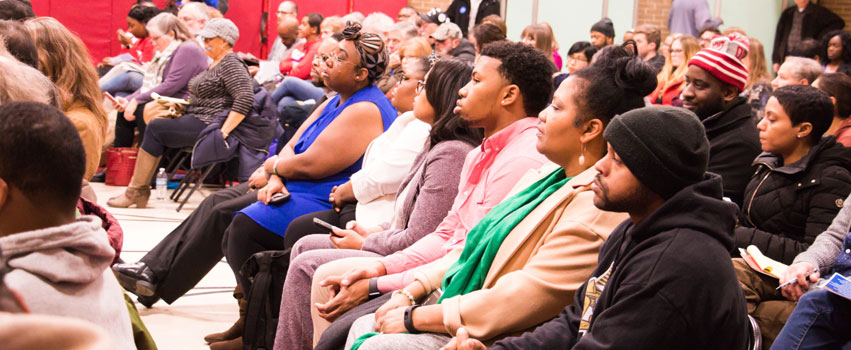Freeze Frame: Capturing Moments in Time
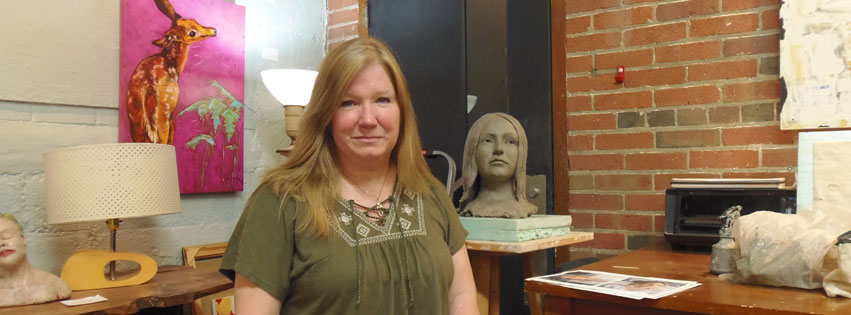
Connie Andrews’ portraits and sculptures often transcend time, telling a story within a story. “The passage of time is a theme I like to explore,” she explains. “I look for ways to tell a story of a few seconds, or even decades, in the context of a confined space—the way a person changes over the decades, or the movement of hands over a piece of work.”
With that in mind, she never takes a project at face value. Getting to the essence of her subject requires time and reflection, and it’s at the heart of her work. “If I were to just take a photograph and paint it as I see it, that would be pretty easy,” she notes. “To make it really touching and meaningful… I add to it and make it a piece of art.”
Layers of Meaning
A woman once came to Andrews shortly after her wedding, asking her to paint a portrait. She brought along a few photos—all striking, professional shots. “One of her favorites was of her and her husband dancing, with him spinning her around. It was really beautiful—I couldn’t improve on the photography,” Andrews explains. Using the photos for reference, she combined several shots to create “A Whirl of Their Own,” layering the couple’s movements to illustrate a range of motions—the bride and groom at different angles, her dress swirling around the scene.
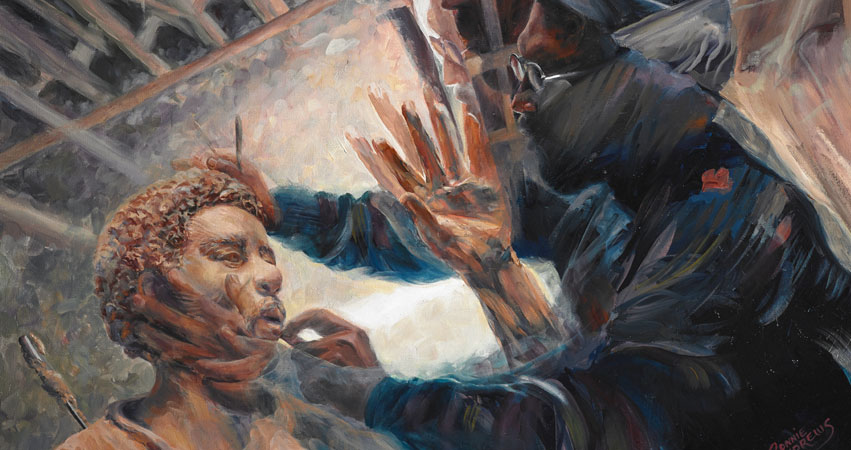
Andrews gained wider recognition for this technique when she won the 2015 ArtPop Peoria competition for her portrait of Preston Jackson sculpting his famous Richard Pryor statue. “I had been working on a ‘hands-in-motion’ series, and he let me take pictures as he worked,” she says. “Then, using Photoshop, I played with some of my favorite pictures… to find the right composition.”
She employed the same technique for “Right Before My Eyes,” capturing her youngest daughter Ruby in various dance poses from ages five through 12. The image came to her in a dream—she was talking with Ruby’s dance teacher about how she arranges the photos they’ve taken over the years. “I had this vision… woke up and scribbled it out,” Andrews recalls, and it became one of her favorite pieces. “I don’t know that the painting technique is perfect—but I like what it means, and I like the effect it has on people.”
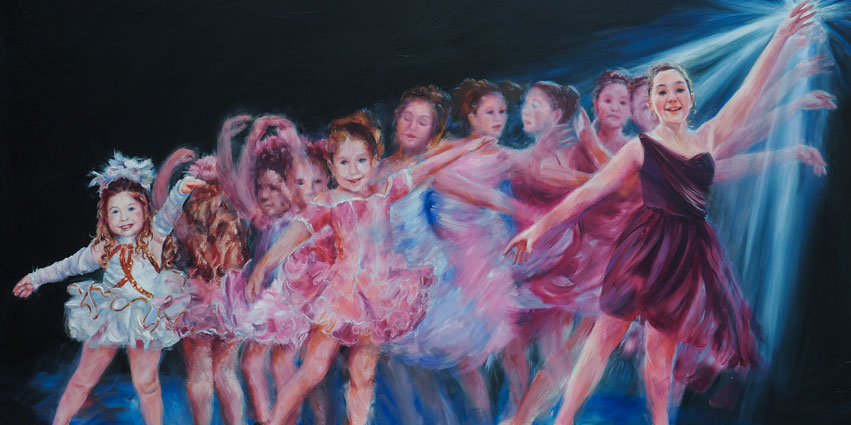
Andrews shares a studio with fellow artist Billie Howd at the Studios on Sheridan in Peoria, while also maintaining a studio at her home in Morton. She enjoys the solitude of working alone—listening to music and working odd hours—but the space on Sheridan has provided a new level of visibility. “First Fridays bring in a lot of traffic,” she notes, “and that’s where the majority of my business comes from.”
Connecting Past to Present
Several years ago, Andrews received her most unusual commission to date. A couple asked her to paint their grandson, who had passed away 20 years earlier as an infant. The twist: they wanted a portrait of what he would look like at 20 years old had this tragedy never occurred.

Besides photos of their grandson, they provided a variety of images of family members at different ages, so Andrews could observe how they’d changed over the years. “I was able to get a family resemblance… but it took me a couple of months to work it out,” she notes. “I would work on it, and then put it away for a while. Once I really figured out what I was doing, it went smoothly from there.”
The grandparents were eager to see her progress, so Andrews invited them to her studio. They were emotional and overjoyed; the grandfather wanted to take it home right then and there, although it wasn’t finished. “I thought they were just going to come and look at the progress I was making, but he didn’t want me to do anything else to it,” she explains. The painting was still very wet, however, so several other artists helped her photograph it and carefully package it for them to take home. Jobs like this—connecting past to present—make her thankful for her path in life.
New Directions
Mostly self-taught aside from a handful of workshops, Andrews has been painting full time for 20 years. Recently she expanded her repertoire to include sculpture, which now accounts for about half of her commissions. But she wasn’t always confident in the new medium.
At 18, she enrolled in a sculpture class at Illinois Central College, but quit after the first assignment. “The teacher gave us a block of compressed sawdust and told us to make a sculpture out of it using only sandpaper,” she recalls. “I did it and thought it looked cool at first, but then I second-guessed myself. I remember pulling into the parking lot and just sitting there. I couldn’t go in and I never went back.” She didn’t attempt sculpture again until 2015—but you’d never know that from looking at her very lifelike creations.
Her favorite subjects, naturally, are her daughters. On a recent studio visit, Andrews was hard at work on a relief of Ruby. “She was talking to me and leaning against the door—she just looked so well put together. I was going to do a sculpture of just her, and then I got to thinking it would be neat as a relief, with the doorway and everything.” She also incorporated Ruby’s prom dress into the relief, as well as the buggy she used to push around the house as a kid—a unique way to show her evolution from child to teenager. She is always looking for ways to expand the narrative.
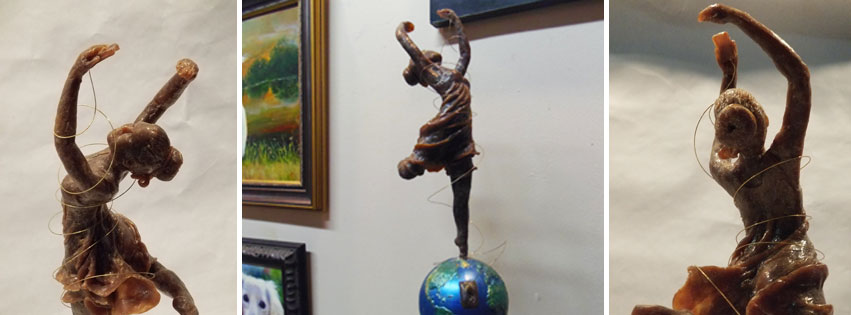
That was again the case when Andrews began work on a wax figurine portraying Ruby at a recent dance recital—but her experience at the performance informed an entirely different direction. “I noticed a lot of people in the audience were looking at their phones… and not really watching the dancers. So I put a phone in [Ruby’s] hand and wrapped a cord around her.” Mounting the figure to a globe and plugging the cord into it, Andrews tapped into a much broader discussion about our addiction to our phones.
Her diligence in getting the form just right is time-consuming, and she is constantly churning out new ideas. “I like it when the piece says, ‘There’s nothing else to do here—it is right,’” Andrews admits. Of course, sometimes the client makes that call, as in the case of the 20-year timelapse portrait from infant to young man. “It was touching to see how the grandparents reacted to that painting. Those are the jobs that really make me feel good about what I’m doing.” PM
To see more of Connie Andrews’ work, go to connieandrews.com or visit her studio at the Studios on Sheridan on a First Friday.
